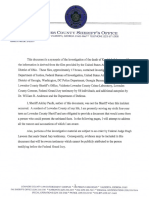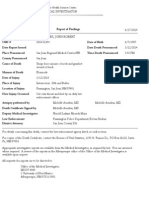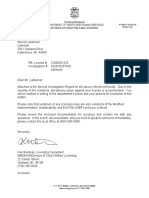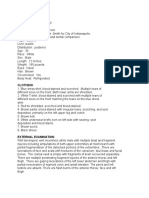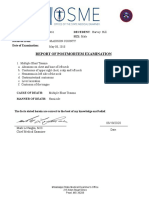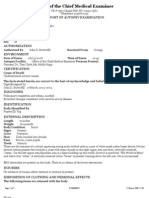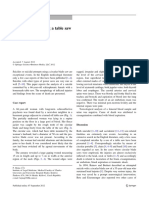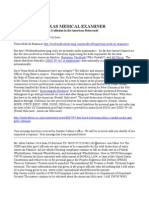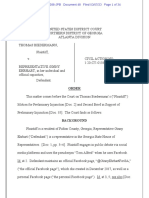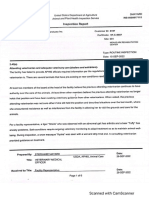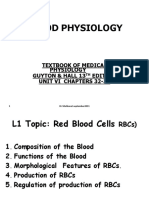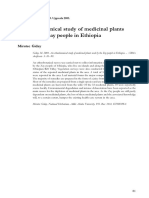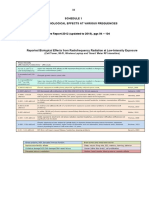Professional Documents
Culture Documents
2023 03 07 Second Autopsy - FINAL
2023 03 07 Second Autopsy - FINAL
Uploaded by
Jennifer SmithOriginal Description:
Original Title
Copyright
Available Formats
Share this document
Did you find this document useful?
Is this content inappropriate?
Report this DocumentCopyright:
Available Formats
2023 03 07 Second Autopsy - FINAL
2023 03 07 Second Autopsy - FINAL
Uploaded by
Jennifer SmithCopyright:
Available Formats
Kris Sperry, M.D.
Forensic Pathologist
Certified by the American Board of Pathology in:
Anatomic Pathology
Clinical Pathology
Forensic Pathology
MANUEL ESTEBAN PAEZ TERAN
REPORT OF SECOND AUTOPSY
A second autopsy examination is performed on the body of Manuel Esteban Paez Teran,
at the Connor-Westbury Funeral Home in Griffin, Georgia, on the 31st day of January,
2023, commencing at 1230 hours.
NOTE: The decedent died of multiple gunshot wounds, and the initial autopsy
examination had been performed by the Dekalb County Medical Examiner’s Office, in
Dekalb County, Georgia, by Dr. Gerald Gowitt. As part of the initial autopsy examination,
multiple x-rays would have been obtained, both to evaluate the gunshot injuries, and to
locate projectiles and projectile fragments within the body. Portions of the decedent’s
body were extensively dissected, in order to find and retain projectiles and projectile
fragments for later scientific forensic ballistic evaluation. Additionally, all of the body
organs were removed, dissected and examined, then placed within a viscera bag, which
was found within the thoraco-abdominal cavity. These procedures are normal and
conventional, and parts of a standard forensic autopsy examination. The focal extensive
dissection, dissection to locate and remove projectiles, and other procedures limit the
ability to accurately discern and identify each individual gunshot wound injury that was
sustained by the decedent. Furthermore, it is not possible to accurately determine the
caliber of a bullet by examination of the perforating injury that had been caused by that
bullet. Nonetheless, the general types of missiles which have caused certain perforating
and penetrating gunshot missile injuries may be concluded, based upon the
characteristics of each individual wound and wound track. Finally, as the decedent was
shot multiple times, by different firearms, many of the wound tracks within his body
converge, coalesce and intersect, rendering the ability to accurately determine each and
every individual wound track very limited, if even impossible. No projectiles were
recovered during the course of this second autopsy examination. These caveats must
be kept in mind when this report is read.
The body is that of a well-developed, well-nourished appearing Caucasian male, who has
a slim build, and appears to have weighed approximately 140 to 150 pounds and had a
height of approximately 65 to 66 inches.
The scalp hair is black, wavy, long, and measures to a maximum of 25 cm in length. A
black moustache and beard are worn, which are curly, and measure to 4 cm in length.
Tattoos include a compass star on the left shoulder, and a small blue flag to the left of the
anterior chest midline.
Sperry Forensic Pathology Consultants
Dr. Kris L. Sperry
3/9/2023
Page 2 of 5
The body has been previously autopsied. A conventional Y-shaped incision is on the
anterior body, beginning over the anterior shoulders and terminating at the pubis, then
branching and extending into the anterior right and left anterior thighs, legs, and into the
dorsal feet bilaterally. The upper and lower extremities are thin, but well-muscled, and
unremarkable, except for gunshot injuries.
The usual bicoronal scalp incision is present, and the cranial vault is in place against the
lower skull. The brain has been removed, and the dura stripped. The teeth are normal.
The lips and gums are unremarkable. The left eye is intact, but the right eye is ruptured
by a gunshot wound; vitreous fluid has been removed from the left eye globe. The neck
is flat. The chest plate is in place on the anterior thorax, and the viscera bag is in place
within the thoraco-abdominal cavity. The testes have been removed from the scrotum,
and the penis is uncircumcised. The anus, perineum and back are unremarkable.
The following gunshot wounds are located and identified. These are listed in no particular
order, and it is not possible to determine the order in which these wounds were sustained.
Additionally, none of the identified firearm wounds exhibited any evidence of close range
firing (the presence of gunpowder soot and/or stippling), and for the purposes of this
report, the range of fire for all of these wounds is considered to be “indeterminate.”
Transient evidence of close range firing, specifically gunpowder soot, may have been
washed from the body during the first autopsy, but this is very unlikely. Finally, if the
decedent was within a tent or other similar shelter when he was shot, the intervening
material would have prevented any soot and stippling particles from reaching his body
surfaces. If the decedent was within some sort of shelter when he was shot, then forensic
analysis of the shelter material will disclose any evidence of soot and/or stippling.
1. Within the medial right orbit is an entrance gunshot wound. This missile passes
essentially straight backwards, with no upwards or downwards deviation, and
would have perforated the brain. The missile track terminates in an outwardly
beveled fracture on the interior of the right occipital bone, just to the right of the
midline. The cranial vault also exhibits several comminuted fractures. This injury
was most probably caused by a handgun projectile.
2. On the left upper chest is a gunshot entrance wound, which is consistent with
handgun ammunition. This wound is below the left clavicle, and the trajectory
appears to be from front to back, slightly upwards, and with no right or left
deviation. A gunshot wound on the left upper back appears to correspond with this
entrance wound on the front of the chest. This missile passed through the left 2nd
rib, and wound have passed through the left lung, and possibly the heart and/or
aorta.
3. On the left lateral abdomen, below the costal margin is a gunshot entry wound,
consistent with handgun ammunition. The track enters the abdominal cavity and
travels downward. Further characterization of the track is not possible.
Sperry Forensic Pathology Consultants, Inc.
Dr. Kris L. Sperry
3/9/2023
Page 3 of 5
4. On the dorsal left wrist is a gunshot entrance wound, with the corresponding exit
wound located on the volar left forearm. This wound is consistent with handgun
ammunition.
5. The volar left hand is involved by a complex entrance wound, consistent with
handgun ammunition. The entrance appears to be located at the base of the left
3rd finger, and the missile travelled into the left palm, with a laceration of the distal
left 3rd finger pad, and a large laceration on the palmar 3rd finger base. Another
large laceration is at the base of the left thumb. This complex wound indicates that
the decedent’s left arm and hand were raised in front of him when he was sustained
this wound, with his palm facing the front of his body.
6. On the volar right forearm is an gunshot entrance wound, consistent with handgun
ammunition. The track passes sharply from proximal to distal (i.e., towards the
elbow), and has a corresponding exit wound in the medial forearm.
7. On the right hand is an entrance gunshot wound, at the base of the thumb and first
finger. This gunshot wound exits from the right palm, through a long laceration
within the thenar eminence of the palmar thumb.
8. The tibia and fibula of the left leg are fractured. A large gunshot defect, consistent
with having been caused by a shotgun slug, enters the lateral left calf, and exits
through the medial calf. On the anterior right thigh is a large are of missing skin
and subcutaneous tissue, measuring 10 X 12 cm. This may represent a
continuation of the apparent shotgun slug injury of the left leg. This would also be
consistent with the decedent being a sitting position, somewhat cross-legged,
when he received this gunshot injury.
9. The dorsal right foot is involved by a very complex grouping of multiple individual
perforations disruptions of the skin, subcutaneous tissues, fascia, and bones of the
foot and toes. This cluster of multiple perforations is typical of a shotgun shot shell
injury, with early separation of the shot pellets, at an approximate range of 10 to
12 feet. The pellet spread would be affected to some extent by any intervening
material or frangible surface. These pellets may have been buckshot, but could
have been smaller diameter shot.
10. A gunshot entrance wound is located within the scrotum, at the base of the penis.
The trajectory of the missile travels into the pelvis, and appears to go downward
into the pelvic region, and slightly from left to right. The left iliac wing has been
removed during the first autopsy, most probably to gain access to a retained
missile. An apparent bullet defect is located within the left sacrum, and this is
consistent with handgun ammunition.
11. On the right upper chest is a gunshot entry wound, consistent with handgun
ammunition. This wound track fractures the right 2nd rib, and would have passed
through the right lung, with fractures of the posterior right 2nd-5th ribs.
Sperry Forensic Pathology Consultants, Inc.
Dr. Kris L. Sperry
3/9/2023
Page 4 of 5
12. On the proximal right thigh is a gunshot entry wound, which is consistent with
handgun ammunition. The track passes into the lateral right thigh, and two
perforations are located within the lateral right buttock, which most probably
represent exit wound defects. The core and jacket of this missile may have
separated, to cause two exit defects.
13. Multiple entrance defects are scattered over the right lower leg, with associated
fractures of the right tibia and fibula. These defects were most probably caused
by buckshot pellets from a shotgun.
14. On the anterior left thigh are two entrance defects. The tracks associated with
these defects pass markedly upwards (proximally) within the thigh, and
corresponding exit defects are located in the medial thigh. These are consistent
with buckshot pellet injuries.
The viscera are examined. All of the body organs have been extensively dissected. The
brain sections are hemorrhagic, relating to the gunshot wound of the head. The right and
left lung sections are hemorrhagic, with focal identified bullet perforations through the
parenchyma. There are no pathologic or pre-existing disease abnormalities involving any
of the internal organs.
OPINIONS AND OBSERVATIONS
This 23 year old male, Manuel Esteban Paez Teran, sustained multiple gunshot wounds.
The majority of these wounds produced wounding patterns typical of handgun
ammunition (such as 9mm, .40 cal., and .45 cal). Evidence of shotgun wounding patterns
were also identified: One large wound of the left leg, with fracturing of the left tibia and
fibula, appears to be consistent with a shotgun slug. At least two separate shot shell
injury patterns were identified, involving the right foot, and scattered over the right leg and
thigh, and possibly the left thigh.
At the time he was shot, the missile entrance and locations, and the missile trajectories
through the body, indicate that the decedent was most probably in a seated position,
cross-legged, with the left leg partially over the right leg. Several of the individual bullet
wounds passed into his body, travelling downwards, and from front to back; these
trajectories are also consistent with the decedent being in a sitting position, on the ground,
with the incoming fire having originated from armed individuals who were standing
towards the front of the decedent, and relatively close to the decedent. No obvious
evidence of close-range firing was found associated with any of the gunshot wounds.
There were no gunshot wounds entering the back, or any other posterior surface of the
body. This indicates that the decedent was facing the multiple individuals who were firing
their weapons at him during the entire interval in which the shooting occurred.
Sperry Forensic Pathology Consultants, Inc.
Dr. Kris L. Sperry
3/9/2023
Page 5 of 5
At some point during the course of being shot, the decedent was able to raise his hands
and arms up and in front of his body, with his palms facing towards his upper body. It is
impossible to determine if the decedent had been holding a firearm, or not holding a
firearm, either before he was shot or while he was being shot the multiple times.
The gunshot wound of the head, which entered the right eye region and passed through
the brain from front to back, would have been instantaneously incapacitating and
unquestionably lethal. Other gunshot wounds, which involved the chest and lower
abdomen (pelvis) would have been lethal, but not instantaneously incapacitating. Based
upon these injuries and the organs which were damaged by different gunshot and
shotgun wounds, the gunshot wound of the head would have occurred at some point
towards the end of the shooting sequence, as the gunshot wounds of the hands and arms
indicate that he was able to raise his hands and arms in front of his upper body and chest.
Kris Sperry, M. D.
Sperry Forensic Pathology Consultants, Inc.
You might also like
- Karissa Bowley MotionDocument4 pagesKarissa Bowley Motionaswarren77No ratings yet
- Davis Et Al V General Mills Operations LLC Gandce-24-02409 0001.0Document58 pagesDavis Et Al V General Mills Operations LLC Gandce-24-02409 0001.0khristopher.brooks0% (1)
- Darius Holcomb SLED Full ReportDocument58 pagesDarius Holcomb SLED Full ReportChalmers RoglandNo ratings yet
- Kendrick Johnson Investigation SynopsisDocument16 pagesKendrick Johnson Investigation SynopsisWCTV Digital TeamNo ratings yet
- Vandel LawsuitDocument100 pagesVandel LawsuitJennifer Smith100% (1)
- Banks County InvestigationDocument6 pagesBanks County InvestigationJennifer SmithNo ratings yet
- Federal Lawsuit Against Stingray Cheerleading in MariettaDocument96 pagesFederal Lawsuit Against Stingray Cheerleading in MariettaJennifer SmithNo ratings yet
- Autopsy Report of Jim McDougalDocument11 pagesAutopsy Report of Jim McDougalBatmanrobin Robinbatman100% (2)
- Nicole Brown Simpson - Autopsy ReportDocument11 pagesNicole Brown Simpson - Autopsy Reporthwshaeffer63% (8)
- Three Theories Commonly Cited To Explain The Origin of Anxiety DisordersDocument13 pagesThree Theories Commonly Cited To Explain The Origin of Anxiety DisordersNor-aina Edding AbubakarNo ratings yet
- Autopsy Findings For Mary Jane WilliamsDocument6 pagesAutopsy Findings For Mary Jane WilliamsPeterBurkeNo ratings yet
- John Marszalek II Death InvestigationDocument33 pagesJohn Marszalek II Death InvestigationMagdalena WegrzynNo ratings yet
- Brian Krumm AutopsyDocument7 pagesBrian Krumm AutopsyMichael Cooper100% (1)
- Autopsy ReportDocument9 pagesAutopsy ReportHank LeeNo ratings yet
- SWIFS Office of The Medical Examiner General Policy and Procedures, 128 Pages (01.03.2008)Document128 pagesSWIFS Office of The Medical Examiner General Policy and Procedures, 128 Pages (01.03.2008)jac_blakeNo ratings yet
- Fatality Inquiry Report: Jeffrey & Jeremy BostickDocument54 pagesFatality Inquiry Report: Jeffrey & Jeremy BostickEmily MertzNo ratings yet
- Investigative Report On Student Death at Lakeside AcademyDocument63 pagesInvestigative Report On Student Death at Lakeside AcademyWWMT100% (2)
- Joseph James Supa ComplaintDocument7 pagesJoseph James Supa ComplaintWLUCNo ratings yet
- Asteraceas: Jan ScholtenDocument35 pagesAsteraceas: Jan Scholten19492001100% (2)
- Willard Scott AutopsyDocument5 pagesWillard Scott AutopsySarahNo ratings yet
- An Atypical Case of Suicidal Cut Throat Injury: Egyptian Journal of Forensic SciencesDocument4 pagesAn Atypical Case of Suicidal Cut Throat Injury: Egyptian Journal of Forensic SciencesBob AbramsNo ratings yet
- Suicide by Close-Range Gunshot Wound To The Bridge of The NoseDocument3 pagesSuicide by Close-Range Gunshot Wound To The Bridge of The NosechoirulumamNo ratings yet
- Autopsy ReportDocument5 pagesAutopsy ReportGlenn PerezNo ratings yet
- Boyd AutopsyDocument30 pagesBoyd AutopsyPatLohmannNo ratings yet
- Vonderrit Myers Shooting InvestigationDocument51 pagesVonderrit Myers Shooting InvestigationThe Conservative TreehouseNo ratings yet
- Harvey Hill Autopsy ReportDocument6 pagesHarvey Hill Autopsy ReportKayode CrownNo ratings yet
- Date and Hour Autopsy Performed: Full Autopsy PerformedDocument3 pagesDate and Hour Autopsy Performed: Full Autopsy PerformedAljohn Blaire PantaleonNo ratings yet
- Broward Medical Examiner ReportDocument42 pagesBroward Medical Examiner ReportrabdillNo ratings yet
- Patricia W. Perlow: Lane County District AttorneyDocument4 pagesPatricia W. Perlow: Lane County District AttorneyMeganNo ratings yet
- Eaton County Apparent Drowning Death UnidentifiedDocument5 pagesEaton County Apparent Drowning Death UnidentifiedFergus BurnsNo ratings yet
- AutopsyDocument7 pagesAutopsybreaksthenews100% (1)
- Cullen ReportDocument131 pagesCullen ReportBren-R100% (2)
- Dau Mabil Postmortem ExamDocument5 pagesDau Mabil Postmortem ExamAnthony WarrenNo ratings yet
- Basic Competencies Forensic Pathology Chapter3Document10 pagesBasic Competencies Forensic Pathology Chapter3Riki LiswantoNo ratings yet
- Unusual Suicide Using A Table SawDocument3 pagesUnusual Suicide Using A Table SawMikitaBrottmanNo ratings yet
- LA Coroner's Preliminary Report On Andrew BreitbartDocument1 pageLA Coroner's Preliminary Report On Andrew BreitbartThe Daily CallerNo ratings yet
- Lopez AutopsyDocument6 pagesLopez AutopsyIan McdowellNo ratings yet
- Douglas Freeman AutopsyDocument7 pagesDouglas Freeman Autopsyreef_galNo ratings yet
- 3 Investigation of Death and CODDocument60 pages3 Investigation of Death and CODSindhu BabuNo ratings yet
- Texas Medical ExaminerDocument2 pagesTexas Medical ExaminerAllen Carlton Jr.100% (1)
- Forensic Investigator Report - DR Letter - EmailsDocument7 pagesForensic Investigator Report - DR Letter - EmailsContact 5No ratings yet
- Jermaine Jones Jr. Incident ReportDocument4 pagesJermaine Jones Jr. Incident ReportMatthew EnfingerNo ratings yet
- Autopsy of Amilcar Perez Lopez - San Francisco Medical Examiner Feb. 23, 2015 To March 3, 2015Document27 pagesAutopsy of Amilcar Perez Lopez - San Francisco Medical Examiner Feb. 23, 2015 To March 3, 2015KQED NewsNo ratings yet
- Strangulation ArticleDocument16 pagesStrangulation ArticleMallikarjun DappinNo ratings yet
- The Victim's Autopsy ReportDocument2 pagesThe Victim's Autopsy ReportShan K100% (1)
- Arrest ReportDocument5 pagesArrest ReportChad PetriNo ratings yet
- Psychological Autopsy FNLDocument6 pagesPsychological Autopsy FNLRoman MamunNo ratings yet
- Postmortem Examination Report: W21-1523 Fitzhugh, William EarlDocument6 pagesPostmortem Examination Report: W21-1523 Fitzhugh, William EarlWXMI100% (1)
- 10.b.statutory Provisions of An AutopsyDocument20 pages10.b.statutory Provisions of An AutopsyNgangaKabiruNo ratings yet
- James Holmes Texas A&M Application and CorrespondenceDocument75 pagesJames Holmes Texas A&M Application and CorrespondenceDaniel J. SchneiderNo ratings yet
- Autopsy ReportDocument2 pagesAutopsy Reportapi-277499662No ratings yet
- Report On The Inquest Into The Death of Sayed FaisalDocument12 pagesReport On The Inquest Into The Death of Sayed Faisaldialynn dwyerNo ratings yet
- Former DEA Chief vs. AmazonDocument43 pagesFormer DEA Chief vs. AmazonCameron LangfordNo ratings yet
- Augusta-Richmond County Coroner Investigative ReportDocument2 pagesAugusta-Richmond County Coroner Investigative ReportJeremy TurnageNo ratings yet
- Forensic Toxicology - Drugs and Chemicals - Overview, Definitions, Scene FindingsDocument15 pagesForensic Toxicology - Drugs and Chemicals - Overview, Definitions, Scene FindingsLightNo ratings yet
- Drew Gabrish AutopsyDocument7 pagesDrew Gabrish Autopsyreef_gal100% (2)
- This Is A Solved Case From The Crime Scene Archives. New Cases Are Posted On TheDocument4 pagesThis Is A Solved Case From The Crime Scene Archives. New Cases Are Posted On TheBench KimmerNo ratings yet
- Strack Search Warrant AffidavitDocument8 pagesStrack Search Warrant Affidavit48 Hours' CrimesiderNo ratings yet
- ReportsDocument19 pagesReportsarsegirl100% (1)
- Atlas of Adult Autopsy PathologyDocument294 pagesAtlas of Adult Autopsy PathologyEloy Salazar100% (3)
- Custodial Death-Rape PDFDocument21 pagesCustodial Death-Rape PDFAnonymous 1Ye0Go7KuNo ratings yet
- IID ReportDocument34 pagesIID ReportRyan D.No ratings yet
- PCOME Ingram-Lopez Postmortem Examination ReportDocument8 pagesPCOME Ingram-Lopez Postmortem Examination ReportDylan SmithNo ratings yet
- Alex Gervais Coroner's ReportDocument4 pagesAlex Gervais Coroner's ReportThe Globe and MailNo ratings yet
- Lockett Autopsy ReportDocument12 pagesLockett Autopsy ReportNewsOK100% (1)
- Jurnal ReadingDocument4 pagesJurnal ReadingAmalan SuryaNo ratings yet
- A deceptive case of gunshot entry wounds – Beware of frangible bulletsDocument4 pagesA deceptive case of gunshot entry wounds – Beware of frangible bulletsRanon Barros BezerraNo ratings yet
- Former Chief of Staff Mark Meadows Files Motion To Remove Case From Fulton CountyDocument14 pagesFormer Chief of Staff Mark Meadows Files Motion To Remove Case From Fulton CountyJennifer Smith100% (1)
- Biedermann V EhrhartDocument34 pagesBiedermann V EhrhartJennifer SmithNo ratings yet
- Summary Fire Chief InvestigationDocument8 pagesSummary Fire Chief InvestigationJennifer SmithNo ratings yet
- Report On Child Abuse in The Archdiocese of AtlantaDocument267 pagesReport On Child Abuse in The Archdiocese of AtlantaEllie ParkerNo ratings yet
- Atlanta Medical MoratoriumDocument2 pagesAtlanta Medical MoratoriumJennifer SmithNo ratings yet
- USDA Report On Noah's Ark Animal SanctuaryDocument7 pagesUSDA Report On Noah's Ark Animal SanctuaryJennifer SmithNo ratings yet
- McMichael Plea AgreementsDocument2 pagesMcMichael Plea AgreementsJennifer SmithNo ratings yet
- Letter From Mayor Andre Dickens To Wellstar Health System CEODocument2 pagesLetter From Mayor Andre Dickens To Wellstar Health System CEOJennifer Smith100% (1)
- Indigenous Med System of IndiaDocument21 pagesIndigenous Med System of IndiaSimonVijayNo ratings yet
- The Elephant Man - The Real Elephant ManDocument10 pagesThe Elephant Man - The Real Elephant ManNORITA AHMADNo ratings yet
- GNM Vol IV Nursing Foundation Part 3 MinDocument462 pagesGNM Vol IV Nursing Foundation Part 3 MinJasmine PraveenNo ratings yet
- 8035-Article Text-59635-1-10-20190329Document4 pages8035-Article Text-59635-1-10-20190329Hesti RahmadatiNo ratings yet
- L1 Composition and Function of BloodDocument20 pagesL1 Composition and Function of BloodManila BhatiaNo ratings yet
- Notes On Miasms Heredity and Nosodes 9788131910702Document13 pagesNotes On Miasms Heredity and Nosodes 9788131910702innahifi111No ratings yet
- Audiometría Niños y AdultosDocument7 pagesAudiometría Niños y AdultosgeraldinefonoaudioNo ratings yet
- Dental Hygiene Bab 17Document18 pagesDental Hygiene Bab 17Cinta SalsabilaNo ratings yet
- Neurodevelopmental Disorders2023Document62 pagesNeurodevelopmental Disorders2023Chriziel SanchezNo ratings yet
- Akt RenalDocument4 pagesAkt Renaldzidek7No ratings yet
- Revised Finished T A PaperDocument14 pagesRevised Finished T A Paperapi-540029997No ratings yet
- An Ethnobotanical Study of Medicinal Plants Ethiopia PDFDocument20 pagesAn Ethnobotanical Study of Medicinal Plants Ethiopia PDFFelix Quivio100% (2)
- Approval of Thesis: ApprovedDocument47 pagesApproval of Thesis: ApprovedfiesaiyukiNo ratings yet
- Medical Microbiology and Immunology Flash Cards Rosenthal 2 Ed 2017Document412 pagesMedical Microbiology and Immunology Flash Cards Rosenthal 2 Ed 2017PolandNo ratings yet
- Analisis Kualitatif RM - HandoutDocument34 pagesAnalisis Kualitatif RM - HandoutRidhobae 10No ratings yet
- 5G Health Impact Briefings - Schedules - Final As Sent - 20.8.20Document174 pages5G Health Impact Briefings - Schedules - Final As Sent - 20.8.20Jessica Learmond-Criqui100% (1)
- W2 Emergency ECG (DR Refli)Document47 pagesW2 Emergency ECG (DR Refli)indahflsaragihNo ratings yet
- Latihan Soal Bahasa Inggris Sma HortatorDocument8 pagesLatihan Soal Bahasa Inggris Sma Hortatormrs.saraswati21No ratings yet
- EXTERNALDocument2 pagesEXTERNALMarissa AsimNo ratings yet
- 461 - Rabbit Production-2Document27 pages461 - Rabbit Production-2Softelgin Elijah MulizwaNo ratings yet
- Apraxias RajanPantelyat 2018eLSWileyDocument12 pagesApraxias RajanPantelyat 2018eLSWileySamadhi SalguedoNo ratings yet
- Deformity QuestionnaireDocument2 pagesDeformity Questionnairevikash kumarNo ratings yet
- CHAPTER ONE and TWODocument24 pagesCHAPTER ONE and TWOadegor jeffreyNo ratings yet
- Tanpa Key Soal Penilaian Harian 1 Xi Wajib-2Document5 pagesTanpa Key Soal Penilaian Harian 1 Xi Wajib-2Hatho HimejimaNo ratings yet
- Ancylostoma DuodenaleDocument5 pagesAncylostoma Duodenalegrafei pennaNo ratings yet
- Health 8 - 3Q - 3bDocument16 pagesHealth 8 - 3Q - 3bJohnfree VallinasNo ratings yet
- Crane SafetyDocument9 pagesCrane SafetyAzadh MoosaNo ratings yet
- U.S. Centers For Disease Control and Prevention (CDC) U.S. Centers For Medicare & Medicaid Services (CMS) The Maryland Department of Health (MDH)Document10 pagesU.S. Centers For Disease Control and Prevention (CDC) U.S. Centers For Medicare & Medicaid Services (CMS) The Maryland Department of Health (MDH)David M. Higgins IINo ratings yet



